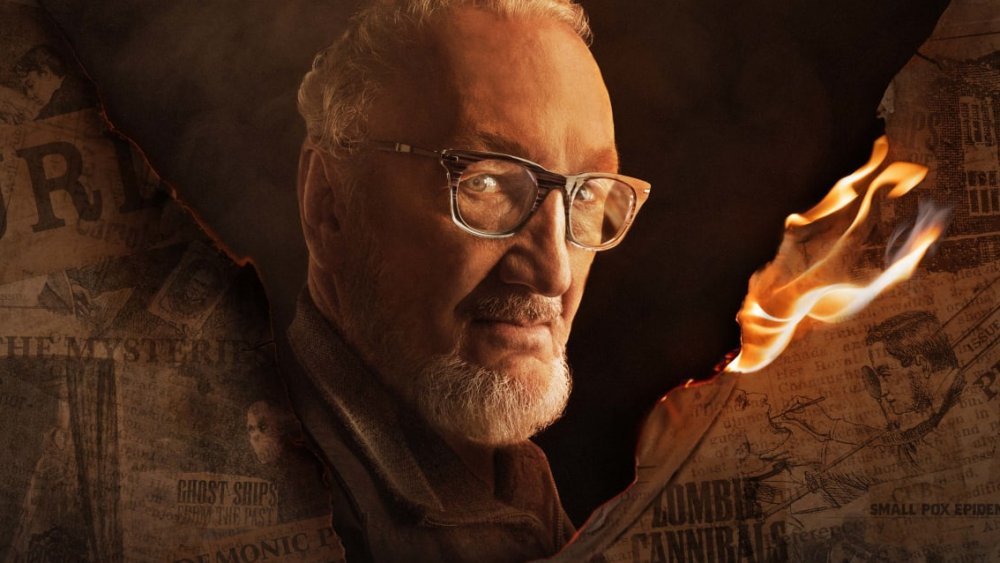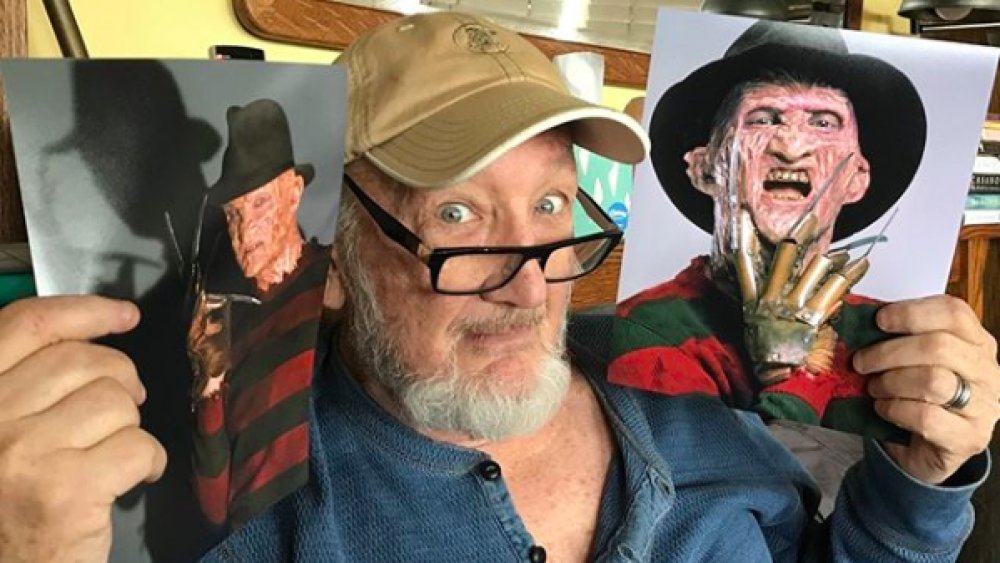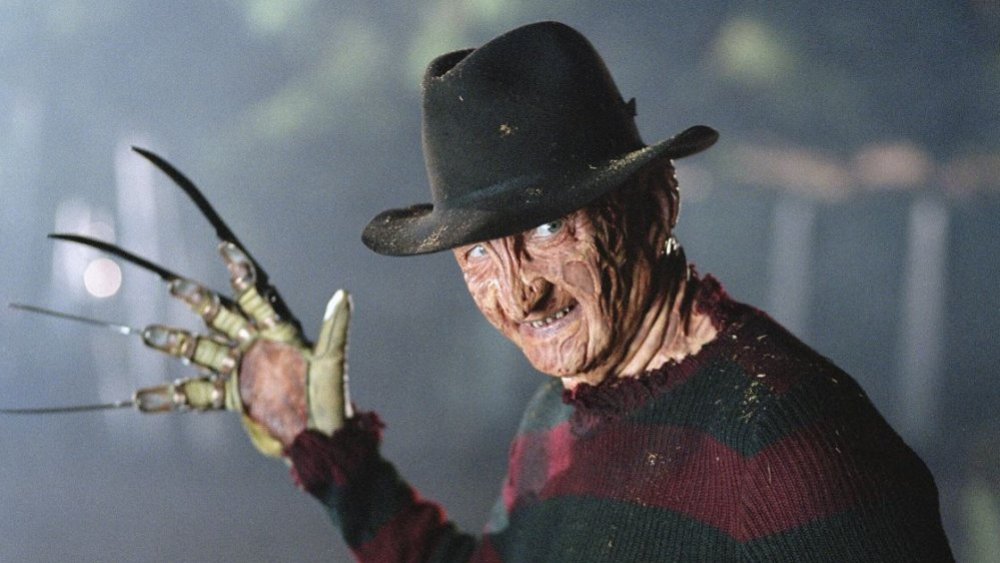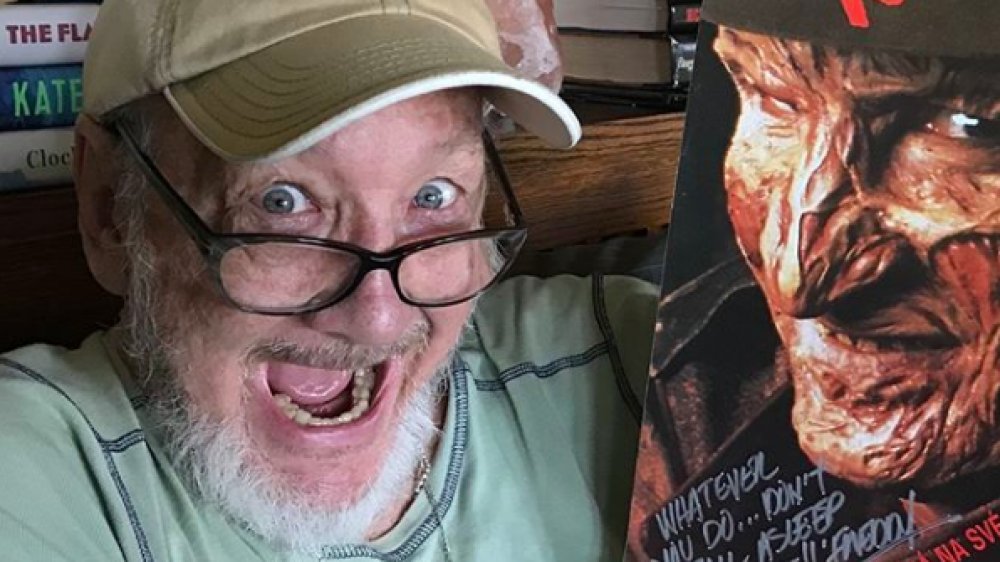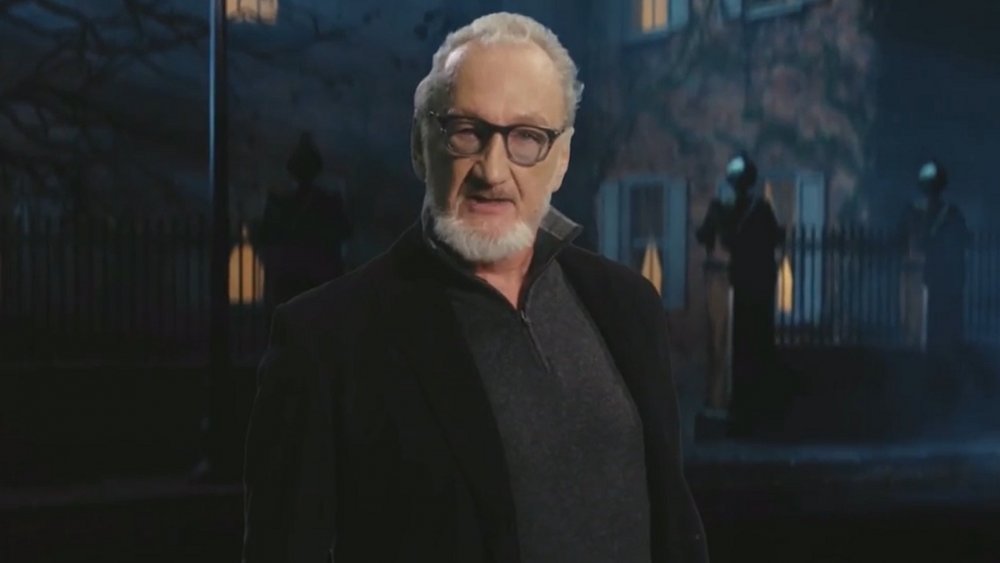Nightmare On Elm Street's Robert Englund Dishes On Freddy Krueger And His Scary New Show - Exclusive Interview
Actor Robert Englund is best known for playing Freddy Krueger, the severely scarred child murderer who haunts victims in their sleep in the Nightmare on Elm Street franchise. He first brought the character with the striped sweater and razor-tipped glove to life in the 1984 original, directed by horror master Wes Craven. Since then, Englund has appeared in all but one of the films in the franchise, his last being 2003's Freddy vs. Jason. And while he wasn't in the 2010 reboot, which starred Jackie Earle Haley as Freddy, he did resurrect his role for a 2018 episode of the hit sitcom The Goldbergs.
In an exclusive interview with Looper, Englund reflected on his four-decade career as Freddy, how the role has changed his life, the new genre of horror he really enjoys, and his new scary series on the Travel Channel. Here's what the veteran actor had to say.
The life-changing effects of Freddy
What impact has the Nightmare on Elm Street franchise had on you and your life?
It was a happy accident for me. In the early 1980s I was in a huge hit series called V. It was the number one miniseries, and then it became a television series. Like Roots, it was huge. It was an international hit and I began going overseas to film festivals and awards shows. Simultaneously, I had a hiatus between the miniseries and the television series and the only project that fit into my schedule was Nightmare on Elm Street. So I did it, and lo and behold it was also an overnight international success. And it made me an international actor overnight.
Because of that happy accident I was able to start working abroad. I've done maybe a dozen movies in Europe. I've done movies in Africa and Russia. I've done movies in South America and Mexico. Lots of movies in Canada. And it's all because of the success of Nightmare on Elm Street.
Horror movies, and science fiction and fantasy films, speak this international language. And that's something you don't learn in acting school or drama school. It's something that your agent isn't really that aware of because they're just trying to get you on the next hit TV show in Hollywood.
Our comedy stars don't travel well. Nobody knows our big comedy stars in Europe, and we don't know their big comedy stars. We know their big action stars, like Jason Statham. We know their big, sexy stars, like Javier Bardem and Penelope Cruz. They know ours. But we don't know their comedy stars. But horror and action movie stars, we cross the Atlantic and Pacific better. We're known in Japan and Latin America. And that was the greatest gift that was given to me by the success of my horror franchise.
What's your favorite memory filming as Freddy?
In 1994 we did part seven, Wes Craven's New Nightmare, and I was done filming early one day. I would come in real early to get my makeup on, like 5 o'clock in the morning. I would start shooting around 8:30 or 9:00. And sometimes I would be done by 1 o'clock. They had a child in that movie, a child witness — it makes you worry more as a viewer — and we had to work around the kid's schedule, so I was usually done by 1 o'clock in the afternoon.
They'd serve this great free lunch on the movie set. I would take my makeup off and run off to get my free lunch — I always love a free lunch —and I would eat with the great actor John Saxon, who was a big teen star in the 1950s. He knew everybody — everybody — in Hollywood. I'd have lunch, and since I wasn't working anymore I'd have a glass or two of wine, and I'd sit down with John. I got stories about Elvis Presley, and James Dean, and Natalie Wood, and Audrey Hepburn and Marlon Brando. He worked with all of them. I got stories about Bruce Lee, and stories about working with great directors like John Huston. I got stories about Clint Eastwood and Robert Duvall. He worked in Robert Redford's very first movie, and even had better billing than Redford.
I got all these stories about what they were like when they were young and how the studios used to make them have these pretend dates. They would pair you up with another actor that was under contract at the same studio and make you go out like you were dating. Then the publicists and the press would photograph you out at a fancy restaurant. He was telling me all that stuff. It was my oral history of Hollywood in the '40s, '50s, and '60s through the eyes of John Saxon. I'm just old enough to know everybody he was talking about and to be a fan of those actors as well, so it was so great.
Getting into character
Is it hard playing such a bad guy? How do you get into character?
I learned back in my theater days that villains are better written. I used to play a lot of best friends and sidekicks. When I was younger, I played a couple of leading men. I was in a hit production of Life with Father, which was funny. I had a lot of laughs in that. I did a lot of comedy. But bad guys are just better written. They're a little more complex. They've got more layers. It's fun to do.
Before Freddy, I had become a bit of a snob. I'm classically trained and came from the theater [world], and I liked art movies. But there was a really great moment for me when I was talking to Wes Craven about the role and the challenges of the makeup. I didn't realize this until maybe five years ago, but when I was a kid I was obsessed with Lon Chaney.
My uncle had a coffee table book and it had all these pictures of Lon Chaney as his different famous characters in makeup. He was called the man of a thousand faces because of all these wonderful characters. Of course, he's best known from The Phantom of the Opera. I was so intrigued with that. And I think that way down deep inside of me there was a little bit of Robbie Englund, the kid, left when I said yes to Wes and A Nightmare on Elm Street.
I was always wanting to meet the challenge of the makeup. When I finally got all that makeup on and found the voice and the way the character moved, I realized I didn't have to worry about what Robert Englund looked like. I was hidden under the makeup, so I could use all of these tricks that I had from theater: Changing my voice, changing the way I moved.
It was larger than life. I had to live up to the exaggerated scenery and special effects that were going on around me. Freddy exists in the imagination of his potential victims, which means he could be portrayed a little bit stylized. It was really liberating for me to play the part because I had just come from doing television, where there's a little voice in your head that says, "Don't get caught acting." You're fighting that all the time and trying to be very still and very quiet and not really act. So it was very liberating. I think I'm a better actor for it now that I've come back to working without the makeup.
What was it like slipping back into the character for The Goldbergs?
They were so sweet. Creator Adam Goldberg sent me the loveliest email I've ever gotten in my life. He told me that that show is a celebration of his memories, and he can still close his eyes and go back. And Nightmare on Elm Street is this great memory he has of the '80s and an innocence that was still part of America back then.
The show is through the lens of a young Jewish-American kid with his possessive helicopter mom. And it was a true episode. He really did have to sneak out to watch Nightmare on Elm Street on VHS at his next-door neighbors' house. It really did scare him. I have been very protective of Freddy, both the character and the franchise, over the years, but I thought if I were ever going to stray this would be the time to do it.
Over the years, I've met thousands of fans whose memory of Nightmare on Elm Street is not a horrible, violent film. It's watching it with their moms and dads, and brothers and sisters, after the whole family went out to a video store to choose a movie to watch on the weekend. They stayed home and they sent out for pizza. Maybe later on that night dad scared them by going outside and taking a garden tool and scratching the window. Or an older brother dressed up like Freddy to tease them. Or they sang the song the little girls with the jump rope sing to scare other kids. They have these great, fond memories of a family experience.
My decision to do The Goldbergs was because I realized that a lot of those people were now watching the show, and they loved the show for those very same reasons. I thought it would be fun for Freddy to put in an appearance. But also, I have to be truly honest here, I just wanted to work with Wendi McLendon-Covey because I'm such a fan of hers. She is one of the funniest women on television today. And it was just such an honor to get to hit my marks alongside her. It was a lot of fun to do.
Creeping out Robert Englund
Do you own any props or memorabilia from the Nightmare on Elm Street movies?
I have the original makeup mold from part two. I have an original pinball machine. But what I really like are the foreign posters, especially the ones where my name is written in Russian or Chinese. I love seeing my name written in a different alphabet. I think that's cool. Also, some of those posters are just really amazing. There is one from Thailand of the phallic Freddy snake from Nightmare on Elm Street 3: Dream Warriors. He's swallowing Patricia Arquette, who's in her Peter Pan Wendy nightgown and arching her back in a combination of terror and pleasure. It's a strange, creepy, weirdly sexual poster. But it's an image of me swallowing an Oscar-winning actress, so I had to have it.
What was the last thing you watched that kept you up at night?
I wouldn't say it kept me up, but I just got through watching The Outsider, the new Stephen King miniseries on HBO, and it's really good. It stars Ben Mendelsohn and Cynthia Erivo, who is up for an Oscar for Harriet. It's a flip on The X-Files. The male detective is the cynic and the pragmatist, and the woman is a little "hoodoo voodoo like you do." She's the believer. And the show is about the concept of the doppelgänger.
There's a new way of dealing with horror: the procedural, like Law and Order, CSI, and Special Victims Unit. In The Outsider, you go through all of the procedures, all of the facts, all of the possible things that could've occurred that cops would go through. They eliminate them one at a time until it gets down to the end and you realize there's nowhere else to go and that you're dealing with some real evil doppelgänger stuff. There's no other explanation, nowhere else to go but just believing it — that the doppelgängers are here. Like Invasion of the Body Snatchers. It's that kind of creepy, and I really, really liked it.
A doppelgänger is not necessarily a monster, it's a virus. It duplicates itself just like you, and then it has to survive, and feed. But the only real horror element throughout is that on the people that are being replicated you see blisters on the back of their necks. Just that simplicity of the blisters on the back of their neck, it freaked me out. It's really nasty and dark.
I also like the turn-of-the-century English series Penny Dreadful. It takes place in Jack the Ripper's London with Frankenstein, and Dorian Gray, and Renfield from Dracula, and the Wolf Man. All those characters are in it. It was a great series. It ended, but it's coming back, this time set in L.A.
The true terror behind Robert Englund's new show
How did the idea for your Travel Channel series True Terror come about and what interested you about the concept?
One of the producers was very influenced by that old TV show Unsolved Mysteries with Robert Stack. He wanted to do a contemporary version of that, but even darker. We can get away with a little more now on cable. We can be a little darker.
The idea was to find things that had been reported in newspapers in American history. Now, Americans are less superstitious than we were 100, 150 or even 50 years ago. We're more sophisticated now. But at one point, we were more open to these kinds of reportings, so they had a certain credibility and validity.
The creators of the show got a research team to dig into it. And they found these crazy, dark stories throughout history that were being reported in newspapers all over the country. The show does reenactments of these stories, and we pieced them together as thematic segments. We have one show about strange beasts, another about ghost stories, and another about serial killers. Just really strange things.
Because they're historical, you have that distance from them. You can look back and see what Americans believed, or the kind of tabloid news they liked 100 years ago. It's different from today. Also, some of the stories are true. They really happened. One of the segments is about the smallpox epidemic in New Orleans [in the 1800s], and it's close to what's going on now [with the coronavirus pandemic]. It gives us a sense that we've been through this before, and we'll get through it again.
In that episode a man is buried alive...
Fear of that is very universal. Being buried alive, suffocating, falling, drowning... these are all dreams that everybody has at some point in their life. I know about this not because I play Freddy Krueger, but because I once I took a class at UCLA about dream analysis where they talked about how everybody shares certain primal fears. We see it so many times in horror movies with the dirt hitting the coffin and somebody trapped inside alive. That's become somewhat of a staple now in horror movies because it's so universal.
What's your favorite scary spot that you've traveled to?
I went to Dracula's castle. I've done several movies in Romania. My wife came with me once and we went to the castle. It's up in the Carpathian Mountains, which are beautiful. They're jagged like the mountains behind Jackson Hole in Wyoming, the Tetons. There's always snow. They're beautiful, but it's really scary and eerie.
What, if any, genre of acting have you always wanted to do but haven't had a chance yet?
I'm getting too old to play him, but I understudied Iago years ago in a production of Othello at Great Lakes Shakespeare Festival [in Ohio]. There was a great actor playing Othello, Roger Robinson, who won a Tony a couple of years ago. He passed away, but I really wish I could've done the show with him. That would've been a great challenge, one of the great villains of Shakespeare. I never got to go on as the understudy, and I regret never getting to do that.
But True Terror is fun. I'm dealing with the challenge of being an on-camera host and an off-camera narrator, and blending those two things. You have to make these decisions about when to be theatrical and when to be conversational. I'm taking cues from the guy that does Dateline [Lester Holt]. He does such a good job. It's tricky, but I like the challenge.
We've done six episodes and I want to do more. I've got all these new ideas, not only for content but also for ways to blend me into it a little bit like the old Twilight Zone with Rod Serling. He would actually be in the episode, and would wrap it up poetically. I'd love to be included in some of the episodes. Like when we're on location in some 300-year-old barn in Gettysburg telling a Civil War ghost story. The camera could move over and find me in the corner of the hayloft with a 150-year-old pitchfork.
